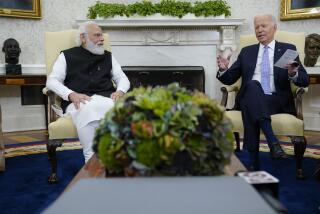THE IDEA OF INDIA.<i> By Sunil Khilnani</i> .<i> Farrar, Straus and Giroux: 263 pp., $22</i>
- Share via
Men and women who have shaped history have often done so because of their obsession with an idea, a vision, a belief in a possibility. Foremost among such ideas has been the idea of India, at once a mythic and philosophic construct as well as a literal space which, once arrived at, offers challenges and realities that are impossible to ignore. The many, often opposed, ideas of what India may be have inspired figures as diverse as Alexander, Qutb-ud-Din, Columbus, Lord Curzon, Max Mueller, Rudyard Kipling and Francesco Clemente to undertake journeys across the world. The vision of India extends from dream to nightmare. It has elicited the lyricism of a patriotic Rabindranath Tagore and the symbolism of an admiring William Butler Yeats. It has called forth the bitter indictment of social practices from a John Strachey and a Nirad Chaudhuri. And in their complex diversity and insistence that each Indian has within him or her a private notion of Indianness, the political ideas of India have confounded India’s own post-independence leaders, from Nehru to Indira Gandhi to Deve Gowda.
Last year, independent India--the second most populous country in the world and, as Khilnani points out, the lone bridgehead of democracy in Southeast Asia--celebrated its 50th birthday. Numerous reviews and reassessments of its achievements have been published, from Gita Mehta’s “Snakes and Ladders” to Shashi Tharoor’s “India: From Midnight to the Millennium.” Sunil Khilnani’s “The Idea of India,” however, offers us something different. Instead of attempting to provide an understanding of India through an examination of the external events that have (seemingly) shaped it, Khilnani analyzes the central internal idea behind modern India, which, he claims, is the idea of democracy. He traces the emergence of this idea and its paradoxical success in a country whose history of feudal and authoritarian rule would have presupposed its failure. He also depicts how this democracy--and the way in which it operates--has undergone numerous changes in the last 50 years.
A professor of politics at the University of London, Khilnani admits that this slim, ambitious book (an essay in five parts) is “fiercely selective.” Central to India’s development is the figure of Nehru, India’s first prime minister, whom Khilnani considers the most fundamental figure in modern India. While some readers may not agree (as I did not) that of all the leaders who fought to bring India its independence--the fiery Shubhash Chandra Bose, the iconoclastic “untouchable” Ambedkar, the cool-headed visionary Vallabhbhai Patel and the idealistic yet canny Gandhi--Nehru was the one whose ideas were the finest, most intellectual expression of the nationalistic imagination, it is certainly interesting and instructive to examine Khilnani’s argument.
Although Khilnani claims that it is not his intention to present Nehru in any detail in this book (he is writing a separate biography that focuses on this), we get a remarkable and complicated picture of Nehru’s personality through even the few personal glimpses we are allowed. The most anglicized of all India’s nationalistic leaders, Nehru was a man who (like Khilnani) was educated at Cambridge and answered to the name “Joe” until his mid-20s. A man who, as he underwent a number of prison sentences during the last part of the Raj, through introspection and musings on his country’s great past and through the writing of his self-exploratory “Discovery of India,” was able to remake himself into an Indian, to develop a deep respect for his multitudinous culture and the diversity of its constituents. This is the Nehru who, during the Partition riots in 1947 between the Hindus and Muslims, embraced the idea of a multiethnic India and “took to the streets of Delhi . . . in order to try and stop the killing and looting, and to assure Muslim families that they could rely on the protection of the state.”
“The Idea of India” is more of an academic study than a book for a lay audience. Unlike Tharoor’s “From Midnight to the Millennium,” which is filled with witty anecdotes and personal stories, Khilnani’s book is dense with historical detail from both pre- and post-colonial times, with references to little-known events, lengthy quotations, statistics, endnotes and a 26-page bibliographic essay. What keeps it from dryness, though, are the intellect and passion of the writer, which are evident, for instance, in a spirited critique of the British Raj and in his ironic inclusion, and exposure, of statements such as philosopher-writer Henri Michaux’s claim, “All the ‘best’ people in India gave [the country] up from the beginning--the great miracle of the English is that now the Hindus do care about it.”
Especially brilliant is Khilnani’s attempt to understand the changing nature of India by studying its urban constructs, both architectural and socioeconomic. It is fitting that he does so, for about 250 million Indians live in cities. By 2010, that number is expected to grow to 400 million, giving India one of the largest urban populations in the world. In the chapter titled “Cities,” Khilnani studies both real and fictional locales. He begins with a portrayal of writer R.K. Narayan’s Malgudi, where post-independence nationalistic fervor, carried to a ridiculous extreme, makes the municipal council give the name of “Mahatma Gandhi Road” to four streets. Khilnani evokes the dismay with which Gandhi himself turned from the filth of the old and holy city of Benares to his idea of the regenerative force of the village, an idea doomed to death after Gandhi’s assassination in 1948. Khilnani examines the way in which the British Raj ghettoized Delhi, segregating the “Old” or “Black” section of town, and how Nehru, in an attempt to take the best of the West while breaking the bonds of colonialism, commissioned the French architect Le Corbusier to build Chandigarh, that eerily ugly “brave new reinforced concrete world.” He details the highly internationalized and entrepreneurial new elite of the “aspiring Esperanto” city of Bangalore, where the computer is king. He makes an analysis and a moving indictment of the uneven distribution of wealth, as revealed by the cityscape of Bombay: “The enclaves of the rich--the old commercial and industrial money set amid the gardens of Malabar Hill, the opulence of the film world emblazoned on Pali Hill, and the newer professional wealth stacked up in the ugly towers of Cuffe Parade--are set apart from the chawls and slums. But Bombay’s congestion makes it impossible for the rich to flee the poor, and the contrasts of lifestyle are vividly adjacent. . . . Some 700,000 [people] exist as they can on the pavements, in segments of sewage pipes and under flyovers. . . . The result is a city that blisters with the aspirations, disappointments and anger of the poor and the lower middle classes. . . . Bombay’s politics is a product of such twists.”
In his introduction, in which he asserts that the idea of democracy has shaped modern India more powerfully than any other idea, Khilnani writes, “If the argument manages to encourage or irritate others into thinking about the larger picture, it will have served one of its main purposes.” This larger picture includes some major successes. The maintaining of democracy in the face of a push to gain economic prosperity with a totalitarian government (as in China) is one. Another is the long-overdue opening (“liberalization”) of Indian economic policy, which has, since 1991, invited in multinational companies such as Hewlett Packard, Agfa and IBM. There are, though, many failures as well, and Khilnani does not flinch from them. He illustrates how the continuing disparity between the rich and the masses of the poor, the corruption and ineptitude of political leaders leading to the rapid collapse of governments, the secessionist demands of regional groups, growing communal violence and the frightening emergence of Hindu nationalistic groups such as the Shiv Sena all pose a threat to its democracy.
Khilnani leaves us with more questions than answers, and perhaps that is his intention. Who is an Indian? Can there be one definition of Indianness? Is a country in which the majority, poor and illiterate, are excluded from the decision-making process truly a democracy? Conversely, what would happen if those people were allowed to enter the democratic process? Will India emerge--as some futurists claim--as a major player in the new millennium? And what might the West, beleaguered by its own not-so-very-different problems--the assertion of group rights versus the claims of the majority, the difficulties of maintaining multicultural political unions--learn from looking eastward? As we spin ever more rapidly toward the 21st century, toward a time when events in Asia create increasing reverberations in America, these are wise questions to ponder.


